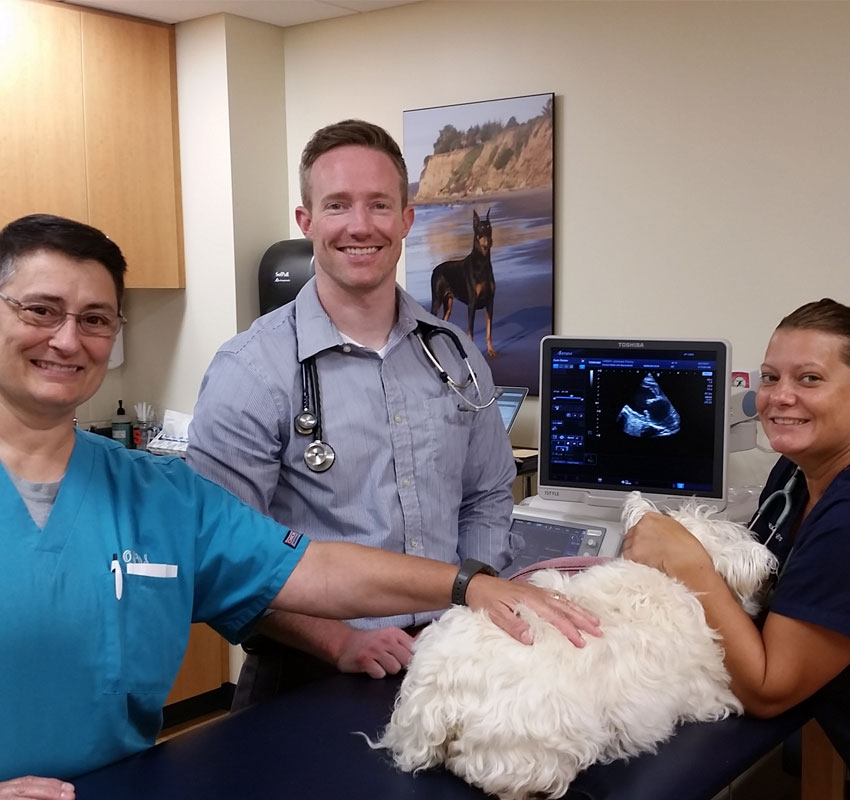How Accurate Are CT Scans For Dogs in Detecting Health Issues?}
The Function of Ultrasound and CT Scan in Modern Vet Practices: Insights From Experienced Professionals
In contemporary veterinary techniques, ultrasound and CT scans greatly enhance analysis capacities. These imaging techniques offer essential understandings into animal wellness, leading therapy decisions. Experienced experts acknowledge the one-of-a-kind advantages of each modality. Ultrasound offers real-time analyses, while CT checks provide complex anatomical information. Understanding their roles and applications elevates important inquiries regarding their influence on client results and the future of vet diagnostics. What insights can be obtained from their incorporated use?
Understanding Ultrasound in Veterinary Medicine
Ultrasound is a crucial analysis tool in veterinary medication, providing a non-invasive technique to picture interior frameworks. This imaging strategy uses high-frequency audio waves to develop real-time photos of body organs and cells, permitting vets to examine conditions without medical intervention. Common applications include assessing the heart, liver, kidneys, and reproductive organs, in addition to keeping track of pregnancies.The procedure is relatively quick and can be executed in different settings, making it an accessible alternative for veterinarians. Unlike radiography, ultrasound gives detailed information concerning soft cells and blood circulation, which is important for accurate diagnoses.Veterinary specialists rely upon ultrasound to identify problems such as growths, cysts, and fluid build-up. Its capacity to direct biopsies and other treatments additionally improves its energy in medical practice. By providing a reliable and risk-free means to examine inner anatomy, ultrasound has actually become a keystone of contemporary vet diagnostics.
The Benefits of CT Checks for Animal Diagnostics
CT checks offer considerable advantages in vet diagnostics by offering boosted accuracy in recognizing interior problems (CT Scans For Animals). As a non-invasive imaging method, they assure the security and convenience of pets during examinations. Furthermore, CT checks facilitate a complete assessment of internal frameworks, enabling extra effective treatment preparation
Boosted Diagnostic Accuracy
Innovations in imaging technology have substantially boosted diagnostic accuracy in vet medicine, specifically with making use of CT scans. These scans give in-depth cross-sectional photos of an animal's internal structures, enabling vets to recognize irregularities with precision. The high resolution and three-dimensional capabilities of CT imaging assist in the discovery of conditions such as lumps, cracks, and inner bleeding that may be missed out on with traditional imaging methods. Additionally, CT scans can help in pre-surgical preparation by using a comprehensive view of anatomical connections. This level of information not only improves the accuracy of medical diagnoses however likewise help in customizing effective treatment plans. Consequently, the combination of CT innovation right into vet techniques is transforming the landscape of pet medical care, boosting end results for people.
Non-Invasive Imaging Strategy
The intro of non-invasive imaging methods has reinvented animal diagnostics, with CT scans becoming a prominent device in veterinary methods. These scans offer high-resolution, cross-sectional photos of a pet's interior structures, allowing vets to examine complicated conditions without the need for intrusive treatments. The advantages of CT scans include their capability to discover tumors, fractures, and inner bleeding with remarkable accuracy. In addition, they assist in the assessment of soft cells and body organs, improving analysis abilities. The rate of CT scanning allows quick decision-making, which is essential in emergency scenarios. By decreasing anxiety and discomfort for the animal, CT scans add to an extra humane technique to diagnostics, ultimately boosting therapy end results and advancing vet care.
Comprehensive Internal Analysis
A detailed internal analysis is necessary for exact medical diagnosis and effective therapy in veterinary medicine. CT checks deal considerable benefits hereof, supplying comprehensive cross-sectional photos of an animal's interior frameworks. This advanced imaging technique boosts visualization of complex physiological regions, enabling veterinarians to recognize irregularities such as lumps, fractures, and internal bleeding with better accuracy. Additionally, CT scans promote the assessment of conditions that may be testing to diagnose with typical methods. The speed and precision of CT imaging additionally contribute to timely treatments, boosting person outcomes. As veterinary methods progressively integrate CT modern technology, the benefits of considerable inner analyses become noticeable, enhancing the value of this device in modern-day veterinary diagnostics.
Comparing Ultrasound and CT Imaging Techniques
While both ultrasound and CT imaging serve crucial duties in veterinary diagnostics, each method provides unique advantages and constraints that can affect professional decision-making. Ultrasound is specifically valued for its real-time imaging abilities, permitting veterinarians to observe vibrant physical processes. This technique is non-invasive, mobile, and does not include ionizing radiation, making it a much safer choice for both clinicians and animals. However, ultrasound may have constraints in picturing particular anatomical structures or deep tissues.Conversely, CT imaging gives detailed cross-sectional sights of the body, enabling exact localization of irregularities. It masters assessing complex body organs and structures, particularly in the thorax and abdomen. However, CT scans need sedation or anesthesia in lots of cases and involve direct exposure to ionizing radiation. Eventually, the selection in between ultrasound and CT relies on the details scientific situation, the area of interest, and the seriousness of the analysis demands.
Case Researches: Effective Diagnoses Via Imaging
Situation researches show the substantial renovations in diagnostic precision attained through sophisticated imaging modern technologies like ultrasound and CT scans in veterinary practices. These developments not just improve the detection of different problems yet likewise help with prompt and effective therapy strategies. Analyzing certain cases can highlight the transformative effect of these imaging strategies on vet medicine.
Analysis Precision Improvements

Imaging Innovation Advancements
As vet imaging innovation remains to evolve, its effect on diagnostic capabilities ends up being progressively obvious. Recent case research studies highlight the successful application of advanced ultrasound and CT scan strategies in identifying complex problems. For circumstances, a veterinary center utilized high-resolution CT scans to diagnose an unusual kind of lung cancer cells in a pet dog, which conventional imaging had missed out on. An ultrasound assessment disclosed an abdominal mass in a pet cat, triggering prompt medical intervention and a positive result. These developments not only boost diagnostic accuracy but also make it possible for vets to devise targeted therapy plans. By leveraging cutting-edge imaging technologies, vet professionals are significantly improving individual care, bring about a lot more effective monitoring of numerous wellness conditions in pets.
The Duty of Imaging in Emergency Vet Care
Imaging plays an essential function in emergency vet treatment, providing veterinarians with crucial information required to make fast, informed decisions. In urgent circumstances, methods like ultrasound and CT scans enable experts to rapidly examine a family pet's interior frameworks, identifying essential problems such as inner bleeding, fractures, or body organ abnormalities. These imaging techniques enable real-time evaluations, facilitating prompt treatments that can be life-saving. For instance, ultrasound is indispensable for evaluating soft tissue injuries and conditions like liquid accumulation, while CT scans offer in-depth photos of complicated physiological frameworks, essential for detecting injury instances. The speed and accuracy of these imaging techniques boost the veterinarian's capacity to create efficient therapy strategies, ensuring the very best possible end results for their individuals. The combination of advanced imaging technologies right into emergency veterinary practices is not just helpful yet progressively necessary, as it boosts analysis abilities and improves general animal treatment during important minutes.

Training and Know-how in Veterinary Imaging
Innovative imaging techniques such as ultrasound and CT scans are essential for efficient vet treatment, the effective implementation of these innovations greatly depends on the training and competence of vet experts. Proficient use imaging devices calls for detailed expertise of anatomy, pathology, and the principles underlying each modality. Vet specialists must undergo customized training to accurately interpret imaging results, which is crucial for detecting conditions and planning treatment.Certifications and continuing education in vet imaging boost the abilities of practitioners, allowing them to remain updated with technological developments. Partnership in between vets and radiologists frequently causes boosted analysis precision, as experts can supply understandings right into intricate instances. On top of that, sensible experience in dealing with imaging equipment fosters confidence in its application. Ultimately, the high quality of veterinary imaging solutions is straight associated to the degree of training and knowledge possessed by the professionals utilizing these vital diagnostic tools.
Future Fads in Diagnostic Imaging for Animals
With the fast innovations in modern technology, vet diagnostic imaging is poised for considerable evolution in the coming years. Arising patterns indicate a change towards more mobile and obtainable imaging techniques, such as handheld ultrasound more devices, which can improve area diagnostics. Furthermore, the integration of expert system is anticipated to transform image evaluation, permitting quicker and much more accurate analyses of results.Moreover, developments in 3D imaging strategies and computed tomography will certainly offer vets with more extensive views of pet composition, leading to better therapy plans. Digital reality modern technology may likewise play a function in surgical planning and education and learning, giving vets a special point of view on complex cases.As telemedicine continues to expand, remote consultations facilitated by analysis imaging will certainly become extra typical, allowing experts to aid family doctors in real-time. Overall, these fads are readied to enhance the effectiveness and performance of veterinary treatment, eventually boosting pet end results.
Often Asked Inquiries
How Much Do Ultrasound and CT Scans Expense in Veterinary Clinics?
The expenses of ultrasound and CT scans in vet clinics typically range from $300 to $1,500, depending upon variables such as location, clinic type, and specific procedures required for the animal's medical diagnosis and useful source therapy.

Exist Any Kind Of Threats Connected With Ultrasound and CT Scans for Pet Dogs?
Ultrasound and CT scans generally position marginal threats to pets. Potential worries consist of sedation reactions and direct exposure to anesthetics. Veterinarians meticulously examine each situation to minimize any type of threats associated with these analysis treatments
Just How Long Do Ultrasound and CT Treatments Commonly Take?
Ultrasound procedures normally take around thirty minutes to an hour, depending upon the complexity. CT scans, being more thorough, usually call for thirty minutes to 90 mins, consisting of prep work and recovery time for the pet dog.
Can All Veterinarians Perform Ultrasounds and CT Scans?
Not all vets can carry out ultrasounds and CT scans. Specialized training and qualification are commonly required to guarantee proficiency in these innovative imaging techniques, which may restrict their schedule to veterinarians with extra credentials and sources.
What Sorts Of Pets Profit Most From These Imaging Techniques?
Specific pet types, specifically felines and canines, advantage greatly from ultrasound and CT scans. These imaging techniques improve diagnostic accuracy for conditions like growths, interior injuries, and organ problems, leading to improved treatment end results and client care. The high resolution and three-dimensional abilities of CT imaging assist in the discovery of problems such as lumps, cracks, and inner blood loss that might be missed with conventional imaging methods. Case researches illustrate the significant improvements in analysis accuracy attained through innovative imaging innovations like ultrasound and CT scans in veterinary practices. Improving diagnostic accuracy in vet practices has been considerably assisted by innovations in imaging innovations such as ultrasound and CT scans. Advanced imaging techniques such as ultrasound and CT scans are vital for effective veterinary care, the effective application of these innovations greatly depends on the training and knowledge of veterinary specialists. Veterinary specialists must undertake specific training to accurately analyze imaging outcomes, which is essential for diagnosing problems and preparing treatment.Certifications and proceeding education in vet imaging improve the skills of experts, allowing them to stay upgraded with technological innovations.